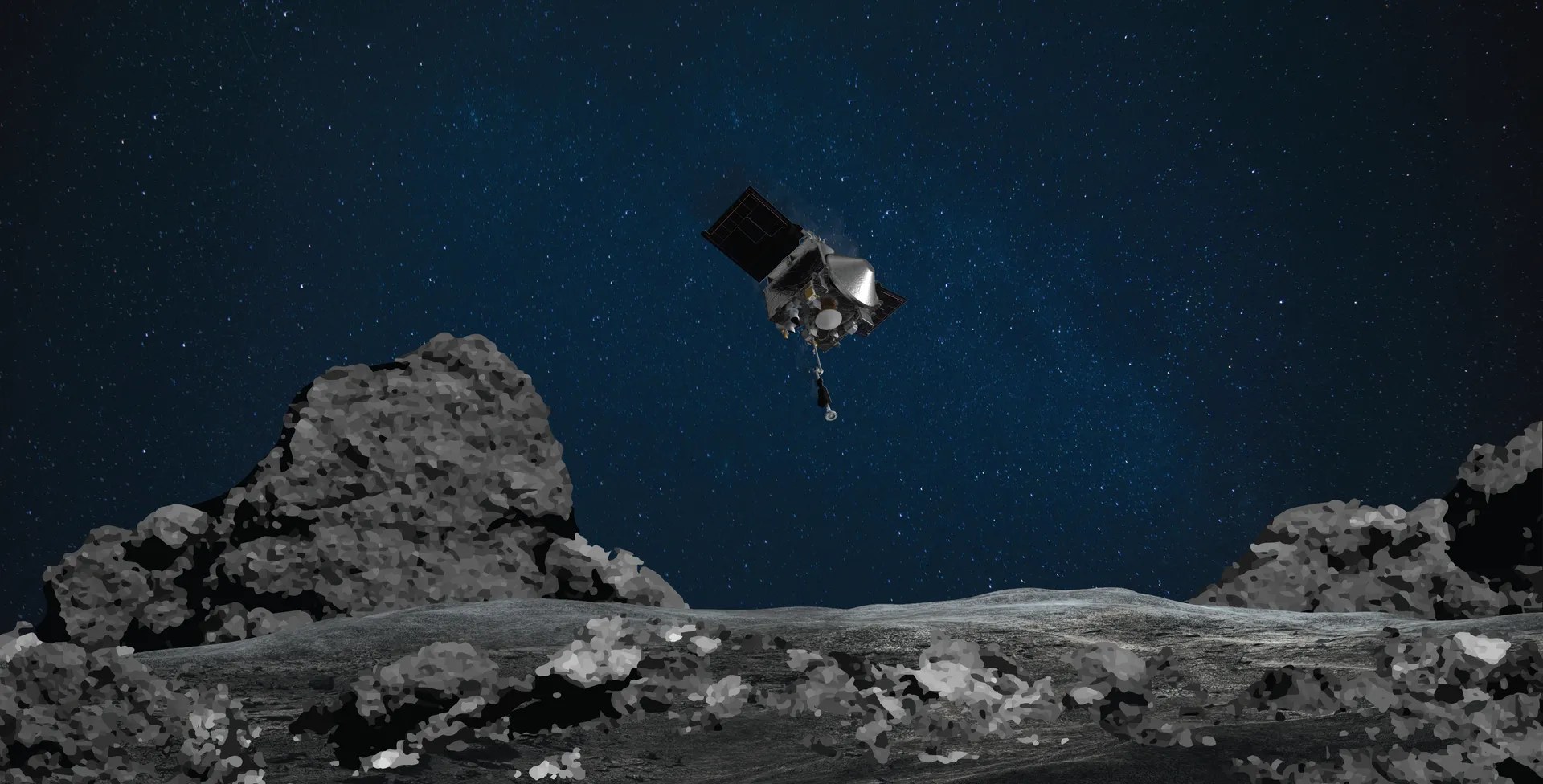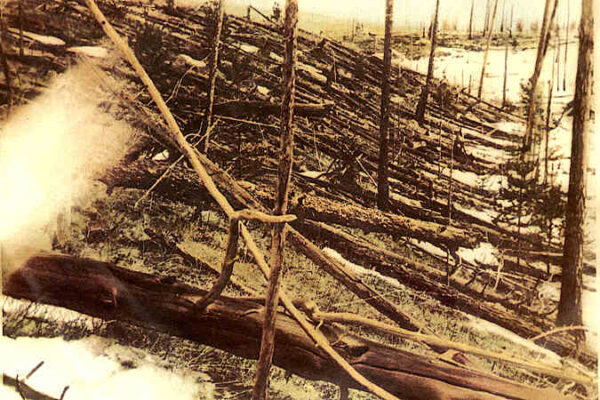
Yesterday, the OSIRIS-REx spacecraft returned from a mission to the asteroid Bennu, which scientists say may be on a slow collision course with Earth. Until recently, scientists tracked relatively few near-Earth objects. Today they know more, but it’s unclear how knowledge will translate to action, historian Andy Bruno writes. Artist’s depiction courtesy of NASA/JPL-Caltech/ASU
On June 30, 1908, a sudden blast knocked down over 2,000 square kilometers of forest in a sparsely inhabited part of Siberia. Witnesses saw a fireball from hundreds of miles away. At least one Indigenous Evenki man, and possibly two more, perished, and several individuals suffered minor injuries.
No one could find a meteorite or a crater near the site of what is now known as the Tunguska explosion. The absence fueled rampant speculation about its cause, with everything from aliens to antimatter considered as possible culprits. But by now, most researchers recognize the telltale contours of an airburst explosion of a stony asteroid, and have concluded that an object from space somewhere between 30 and 80 meters in diameter exploded about 10 kilometers above ground, releasing 10-20 megatons of energy.
For decades after the start of the Space Age, so-called “near-Earth objects”—the asteroids and comets close to our planet—evaded scientific understanding. Investigations into the Tunguska event long influenced efforts to comprehend their character. The more recent explosion of the Chelyabinsk meteorite in February 2013, which scientists failed to see coming, prompted major investment in identifying and tracking near-Earth objects. In 2000, we knew of fewer than 1,000 near-Earth asteroids, and still fewer than 10,000 by 2013. Ten years later, in 2023, this figure is north of 30,000.
The all-encompassing, global threat of near-Earth objects makes them analogous to climate change—and both threats face a similar problem: Scientific knowledge about what is happening doesn’t seamlessly translate into action.
Today, scientists believe that they have located 95% of the asteroids that cross Earth’s orbit and are wider than one kilometer—the ones whose collisions would cause a global catastrophe. Because such large bodies are rare, we would almost certainly have years or even decades to respond.
On a slightly smaller scale, scientists have detected over 2,000 “potentially hazardous objects,” and frequently add new discoveries to the register. These near-Earth objects are wider than 140 meters in diameter, have a chance of intersecting with Earth’s orbit, and could devastate a large region. Various tools exist for assessing their risk, but according to both of the main metrics used—the Palermo and Torino scales—there is currently little reason to worry about any “potentially hazardous objects” over the next century.
One “potentially hazardous” asteroid, the half-kilometer wide Bennu, has been given about a 1 in 2,700 chance of colliding with Earth on September 24, 2182. With so much advanced notice, NASA was able to send the OSIRIS-REx spacecraft to Bennu to collect a sample from its surface. The OSIRIS-REx returned this collected material from Bennu to Earth on Sunday, September 24, 2023. The information from the mission will aid continued efforts to monitor the threat posed by Bennu and learn more about its composition.
Meanwhile, our knowledge about the class of smaller near-Earth objects between 10 and 140 meters in diameter—like the one that exploded over Tunguska—is much more limited. These could still do significant damage depending on their composition and where they hit, eviscerating cities and decimating their populations. Only a small portion of these asteroids have been identified, making it more likely that they could hit with little warning. If anything big barrels our way, we will likely have time to prepare and react. But that doesn’t mean our troubles are over. Scientists and policymakers are still figuring out how to react to learning of an impending cosmic collision.
A United Nations conference on planetary defense held in April 2023 in Vienna discussed scenarios for responding to an asteroid approaching Earth. A lot depends on how far in advance the object is detected. The trajectory of any space body becomes clearer the longer it is monitored. With decades or years of warning, it might be possible to send a spaceship to the asteroid to learn more about its exact size, shape, and composition and to deflect it onto a different trajectory. In 2022, NASA’s Double Asteroid Redirection Test spacecraft intentionally banged into the moonlet Dimorphos, demonstrating one method of changing an asteroid’s course.
Other options for deflection include soaking the space rock with an ion beam, pulling it off course with the gravity of a tracking vessel, or detonating a nuclear explosion nearby.
But deflection would not be an option if only days or weeks remained before an expected impact. Since most smaller objects are still undetected, such a case could easily arise. In January 2023, an asteroid the size of a large truck, which had been noticed only days earlier, whizzed a mere 2,200 miles above Chile and Argentina at the bottom tip of South America.
In the event of a recently discovered object on a collision course with Earth, scientists developing a response would have to consider the size and trajectory of the body, along with the time that remained before its expected arrival. If it appeared on the smaller end and was definitely headed toward an ocean or an uninhabited landmass like much of Antarctica or Greenland, it might be best to leave it alone. But if there was a chance that it could strike an area where people live, authorities would have to order evacuations, immediately. They might also launch a missile to attempt to destroy the object—most likely with an atomic bomb, accepting possible radioactive contamination as a tradeoff.
If authorities couldn’t agree on what to do, they might fail to act, putting humanity at risk.
This might sound similar to the climate crisis, in which political inaction—not scientific knowledge—threatens to saddle humanity with catastrophe. Near-Earth object researchers raised early alarms about threats to the Earth’s climate; some of the same scientists who hypothesized in the 1980s that detonating nuclear weapons could trigger severe global cooling or a “nuclear winter” also researched the Tunguska event and other meteorite impacts. (One group argued that the Tunguska explosion caused a temporary global cooling akin to large volcanic explosions, but this contention didn’t hold up in subsequent research.)
As much as improvements in monitoring and manipulating hazardous rocks from space should be celebrated, they bring with them new responsibilities for—and unresolved questions about— these potential disasters. Who decides how to respond to the impending arrival of a lethal asteroid? Should we trust entities that created and proliferated the nuclear weapons that still threaten one type of disaster to save us from another? And if a large space rock hits, how will people react? Will we come together and rebuild in inspiring ways, or would a cosmic catastrophe spur corrupt shenanigans?
Avoiding another Tunguska requires continued investment in the research and detection of near-Earth objects. A few decades from now, we might be reasonably confident that we will know of anything dangerous in space with enough time to react before the most fraught scenarios of an imminent collision play out. Yet science alone cannot save us—we also need to use that knowledge to inform decisions.
Our inaction in the face of the ecological hazards that we have created here on Earth has shown that knowledge is not the sole barrier to solutions; politics are as well. As with our Earthly problems, our gains in understanding of cosmic hazards may offer little solace if we fail to use them. Human responses to cosmic intruders can pose a threat themselves.





Send A Letter To the Editors